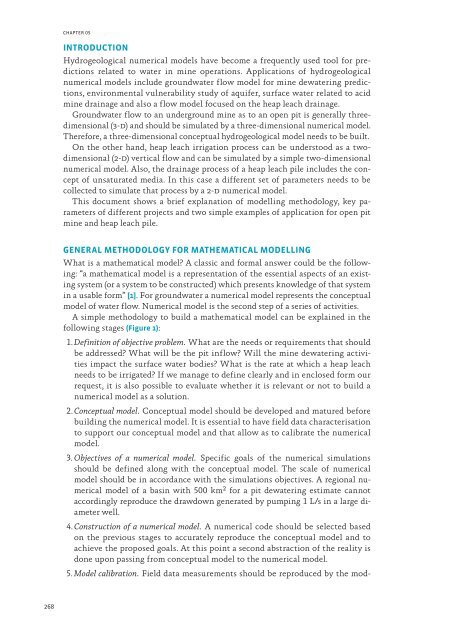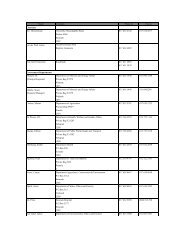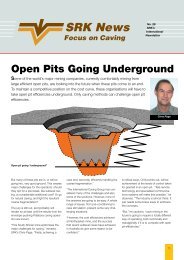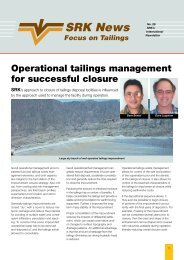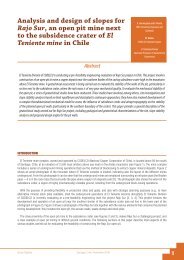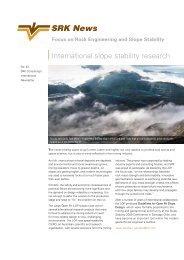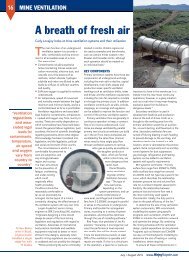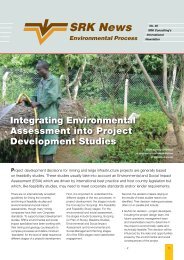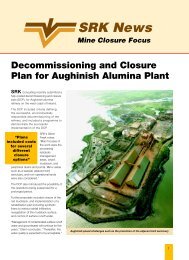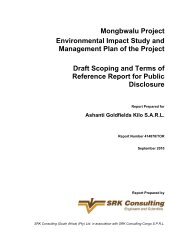Groundwater Flow Modelling Applications in Mining: Scopes and ...
Groundwater Flow Modelling Applications in Mining: Scopes and ...
Groundwater Flow Modelling Applications in Mining: Scopes and ...
Create successful ePaper yourself
Turn your PDF publications into a flip-book with our unique Google optimized e-Paper software.
268<br />
CHAPTER 05<br />
INTRODUCTION<br />
Hydrogeological numerical models have become a frequently used tool for predictions<br />
related to water <strong>in</strong> m<strong>in</strong>e operations. <strong>Applications</strong> of hydrogeological<br />
numerical models <strong>in</strong>clude groundwater flow model for m<strong>in</strong>e dewater<strong>in</strong>g predictions,<br />
environmental vulnerability study of aquifer, surface water related to acid<br />
m<strong>in</strong>e dra<strong>in</strong>age <strong>and</strong> also a flow model focused on the heap leach dra<strong>in</strong>age.<br />
<strong>Groundwater</strong> flow to an underground m<strong>in</strong>e as to an open pit is generally threedimensional<br />
(3-d) <strong>and</strong> should be simulated by a three-dimensional numerical model.<br />
Therefore, a three-dimensional conceptual hydrogeological model needs to be built.<br />
On the other h<strong>and</strong>, heap leach irrigation process can be understood as a twodimensional<br />
(2-d) vertical flow <strong>and</strong> can be simulated by a simple two-dimensional<br />
numerical model. Also, the dra<strong>in</strong>age process of a heap leach pile <strong>in</strong>cludes the concept<br />
of unsaturated media. In this case a different set of parameters needs to be<br />
collected to simulate that process by a 2-d numerical model.<br />
This document shows a brief explanation of modell<strong>in</strong>g methodology, key parameters<br />
of different projects <strong>and</strong> two simple examples of application for open pit<br />
m<strong>in</strong>e <strong>and</strong> heap leach pile.<br />
GENERAL METHODOLOGY FOR MATHEMATICAL MODELLING<br />
What is a mathematical model? A classic <strong>and</strong> formal answer could be the follow<strong>in</strong>g:<br />
“a mathematical model is a representation of the essential aspects of an exist<strong>in</strong>g<br />
system (or a system to be constructed) which presents knowledge of that system<br />
<strong>in</strong> a usable form” [1]. For groundwater a numerical model represents the conceptual<br />
model of water flow. Numerical model is the second step of a series of activities.<br />
A simple methodology to build a mathematical model can be expla<strong>in</strong>ed <strong>in</strong> the<br />
follow<strong>in</strong>g stages (Figure 1):<br />
1. Def<strong>in</strong>ition of objective problem. What are the needs or requirements that should<br />
be addressed? What will be the pit <strong>in</strong>flow? Will the m<strong>in</strong>e dewater<strong>in</strong>g activities<br />
impact the surface water bodies? What is the rate at which a heap leach<br />
needs to be irrigated? If we manage to def<strong>in</strong>e clearly <strong>and</strong> <strong>in</strong> enclosed form our<br />
request, it is also possible to evaluate whether it is relevant or not to build a<br />
numerical model as a solution.<br />
2. Conceptual model. Conceptual model should be developed <strong>and</strong> matured before<br />
build<strong>in</strong>g the numerical model. It is essential to have field data characterisation<br />
to support our conceptual model <strong>and</strong> that allow as to calibrate the numerical<br />
model.<br />
3. Objectives of a numerical model. Specific goals of the numerical simulations<br />
should be def<strong>in</strong>ed along with the conceptual model. The scale of numerical<br />
mo del should be <strong>in</strong> accordance with the simulations objectives. A regional numerical<br />
model of a bas<strong>in</strong> with 500 km 2 for a pit dewater<strong>in</strong>g estimate cannot<br />
accord<strong>in</strong>gly reproduce the drawdown generated by pump<strong>in</strong>g 1 L/s <strong>in</strong> a large diameter<br />
well.<br />
4. Construction of a numerical model. A numerical code should be selected based<br />
on the previous stages to accurately reproduce the conceptual model <strong>and</strong> to<br />
achieve the proposed goals. At this po<strong>in</strong>t a second abstraction of the reality is<br />
done upon pass<strong>in</strong>g from conceptual model to the numerical model.<br />
5. Model calibration. Field data measurements should be reproduced by the mod-


